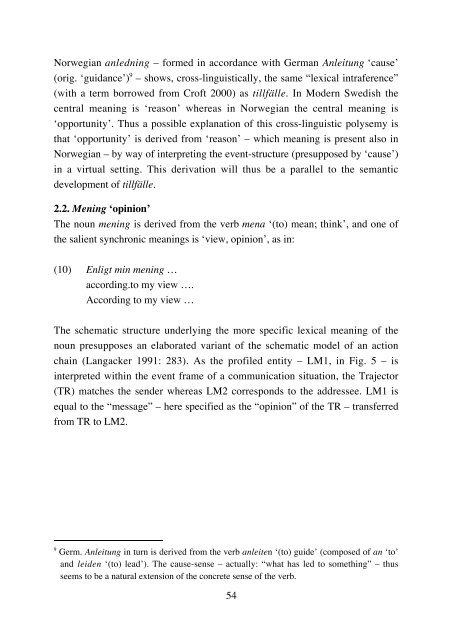Construal operations in semantic change: the case of abstract nouns
Construal operations in semantic change: the case of abstract nouns Construal operations in semantic change: the case of abstract nouns
Norwegian anledning – formed in accordance with German Anleitung ‘cause’ (orig. ‘guidance’) 9 – shows, cross-linguistically, the same “lexical intraference” (with a term borrowed from Croft 2000) as tillfälle. In Modern Swedish the central meaning is ‘reason’ whereas in Norwegian the central meaning is ‘opportunity’. Thus a possible explanation of this cross-linguistic polysemy is that ‘opportunity’ is derived from ‘reason’ – which meaning is present also in Norwegian – by way of interpreting the event-structure (presupposed by ‘cause’) in a virtual setting. This derivation will thus be a parallel to the semantic development of tillfälle. 2.2. Mening ‘opinion’ The noun mening is derived from the verb mena ‘(to) mean; think’, and one of the salient synchronic meanings is ‘view, opinion’, as in: (10) Enligt min mening … according.to my view …. According to my view … The schematic structure underlying the more specific lexical meaning of the noun presupposes an elaborated variant of the schematic model of an action chain (Langacker 1991: 283). As the profiled entity – LM1, in Fig. 5 – is interpreted within the event frame of a communication situation, the Trajector (TR) matches the sender whereas LM2 corresponds to the addressee. LM1 is equal to the “message” – here specified as the “opinion” of the TR – transferred from TR to LM2. 9 Germ. Anleitung in turn is derived from the verb anleiten ‘(to) guide’ (composed of an ‘to’ and leiden ‘(to) lead’). The cause-sense – actually: “what has led to something” – thus seems to be a natural extension of the concrete sense of the verb. 54
TR LM1 LM2 ‘opinion’ COMMUNICATION Fig. 5. The schematic structure of ‘opinion’. In addition to the meaning ‘opinion’, the word shows a number of semantically related meanings, namely ‘intention’ (11a), ‘purpose’ (11b), ‘ sense’ (11c), and ‘sentence’ (11d). (11) a. Meningen är att förstärka partimedlemmarnas inflytande … intention.the is to.reinforce party.members.the.GEN influence The intention is to reinforce the influence of the party members … b. Lydnad är meningen med människans liv på jorden. obedience is purpose.the with man.the.GEN life on earth.the Obedience is the purpose of man’s life on earth. c. i ordets verkliga mening in word.the.GEN real sense in the word’s real sense d. en lång mening a long sentence Opinions are typically expressed by means of verbal communication, i.e. in words and sentences, which (in our culture at least) are conceptualized as some sort of containers (Reddy 1979). In terms of this metaphorical thinking the linguistic form corresponds to the embracing container whereas the linguistic meaning is seen as the content of the container. There is thus a clear connection between ‘opinion’ (10) and ‘sense’ (11c) in that part of the background knowledge of the meaning ‘opinion’ is highlighted (or profiled) in the meaning variant ‘sense’. A verbally expressed opinion is not only an instance of a linguistic sense (wrapped up in words and sentences), but it also manifests 55
- Page 1 and 2: Reprinted from Tre uppsatser om sem
- Page 3 and 4: change may simultaneously be looked
- Page 5 and 6: A further step from the “pure”
- Page 7: As I will argue the meaning ‘acci
- Page 11 and 12: 2.3. Uppgift ‘information’ The
- Page 13 and 14: At first glance the two meanings of
- Page 15 and 16: What the meaning variants of fråga
- Page 17 and 18: As for the meaning variants F1, F3,
- Page 19: SAOB = Ordbok över svenska språke
Norwegian anledn<strong>in</strong>g – formed <strong>in</strong> accordance with German Anleitung ‘cause’<br />
(orig. ‘guidance’) 9 – shows, cross-l<strong>in</strong>guistically, <strong>the</strong> same “lexical <strong>in</strong>traference”<br />
(with a term borrowed from Cr<strong>of</strong>t 2000) as tillfälle. In Modern Swedish <strong>the</strong><br />
central mean<strong>in</strong>g is ‘reason’ whereas <strong>in</strong> Norwegian <strong>the</strong> central mean<strong>in</strong>g is<br />
‘opportunity’. Thus a possible explanation <strong>of</strong> this cross-l<strong>in</strong>guistic polysemy is<br />
that ‘opportunity’ is derived from ‘reason’ – which mean<strong>in</strong>g is present also <strong>in</strong><br />
Norwegian – by way <strong>of</strong> <strong>in</strong>terpret<strong>in</strong>g <strong>the</strong> event-structure (presupposed by ‘cause’)<br />
<strong>in</strong> a virtual sett<strong>in</strong>g. This derivation will thus be a parallel to <strong>the</strong> <strong>semantic</strong><br />
development <strong>of</strong> tillfälle.<br />
2.2. Men<strong>in</strong>g ‘op<strong>in</strong>ion’<br />
The noun men<strong>in</strong>g is derived from <strong>the</strong> verb mena ‘(to) mean; th<strong>in</strong>k’, and one <strong>of</strong><br />
<strong>the</strong> salient synchronic mean<strong>in</strong>gs is ‘view, op<strong>in</strong>ion’, as <strong>in</strong>:<br />
(10) Enligt m<strong>in</strong> men<strong>in</strong>g …<br />
accord<strong>in</strong>g.to my view ….<br />
Accord<strong>in</strong>g to my view …<br />
The schematic structure underly<strong>in</strong>g <strong>the</strong> more specific lexical mean<strong>in</strong>g <strong>of</strong> <strong>the</strong><br />
noun presupposes an elaborated variant <strong>of</strong> <strong>the</strong> schematic model <strong>of</strong> an action<br />
cha<strong>in</strong> (Langacker 1991: 283). As <strong>the</strong> pr<strong>of</strong>iled entity – LM1, <strong>in</strong> Fig. 5 – is<br />
<strong>in</strong>terpreted with<strong>in</strong> <strong>the</strong> event frame <strong>of</strong> a communication situation, <strong>the</strong> Trajector<br />
(TR) matches <strong>the</strong> sender whereas LM2 corresponds to <strong>the</strong> addressee. LM1 is<br />
equal to <strong>the</strong> “message” – here specified as <strong>the</strong> “op<strong>in</strong>ion” <strong>of</strong> <strong>the</strong> TR – transferred<br />
from TR to LM2.<br />
9<br />
Germ. Anleitung <strong>in</strong> turn is derived from <strong>the</strong> verb anleiten ‘(to) guide’ (composed <strong>of</strong> an ‘to’<br />
and leiden ‘(to) lead’). The cause-sense – actually: “what has led to someth<strong>in</strong>g” – thus<br />
seems to be a natural extension <strong>of</strong> <strong>the</strong> concrete sense <strong>of</strong> <strong>the</strong> verb.<br />
54



